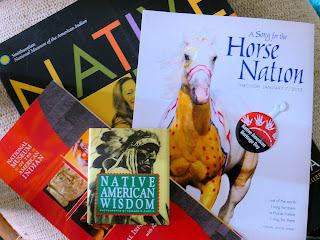All photos by C. G. Wagner; please credit and link if used.
Some takeaways, including the official museum book and a button commemorating today (Nov. 23) as Native American Heritage Day
View from the fourth floor.
Maidu Creation Story (2001) by Harry Fonseca
Background: Kiowa moccasin leggings
Inset: Kiowa Aw-Day (beaded sneakers) by Teri Greeves, 2004
I admit I came to the museum today with no idea that it was Native American Heritage Day (or even American Indian Heritage Month). The day after Thanksgiving is just a good day to explore the unknown parts of my own neighborhood. And I take the broadest sense of that word: the cultures I walk among that are largely strangers to me.
So ignorant am I of this subject matter that, literally, the first I'd ever heard of Squanto was just last night, watching the Peanuts Thanksgiving special (the "Mayflower Voyages" half). So I was happy that the first exhibit I saw today had to do with Squanto, the Patuxet who was kidnapped by Europeans and, upon being returned to North America as a fluent English speaker, helped the Pilgrims adjust to the harsh land and climate.
The signage in the museum directs you to start on the upper floors, where you begin with the beginning, the mythologies of the universe and of creation. I stopped to watch a video presentation of a Cheyenne story about how the Big Dipper was formed. (Down in the bookshop, I could find no book or video or any souvenir of that charming and even tear-inducing story, but here it is at First People's Legends page: "The Quill-Work Girl and Her Seven Brothers.")
You can't help but be impressed by how fully integrated the indigenous peoples of the Americas were (and are) with their environment. It is embedded in the DNA, this reverence and respect for the natural world. I followed the crowd to a display of Alaskan wares, where there was a sheer coat made of an unusual, diaphanous material. Since I was the one standing next to the caption, I identified it for the group as "seal gut." Oooh! was the response. "They didn't waste a thing.... Waste not, want not." We all wondered how it could possibly have kept anyone warm.
"Waste not, want not" needs to apply to people. After having just seen Lincoln and the battle for treating slaves as human beings, I stood there wondering who had been treated worse--Africans who had been kidnapped from their homes and enslaved, or the indigenous peoples whose lands were stolen out from under them and killed outright. (Some of this murder was apparently an accident; the Europeans brought diseases to which natives had no immunity, and their populations were decimated.)
Death and destruction of culture continue even through "modern" times, as Native Americans have had to fight even for the right to educate children in their own languages and customs, and not be confined to a "choice" of either Protestant or Catholic schools.
I have no claims to a religious worldview, but the spiritual connection of humans to each other--and to animals, the land, the elements--makes a lot of sense to me. We are connected to everything and must be, lest we waste whatever it will take for all of our future survivance.
"Limit chaos
And cultivate order:
By singing, dancing, and
Talking to each other.
Realize life is short,
Respect your elders,
And recognize that death
Is a part of living."
--excerpt from "The Maidu Creation Story," told by Henry Azbill, 2002, and put to verse by Judy Allison





1 comment:
I wish I had taken the opportunity to visit the museum when I lived in northern Va. As for "survivance," well, words are added to the American lexicon every year. :)
Post a Comment